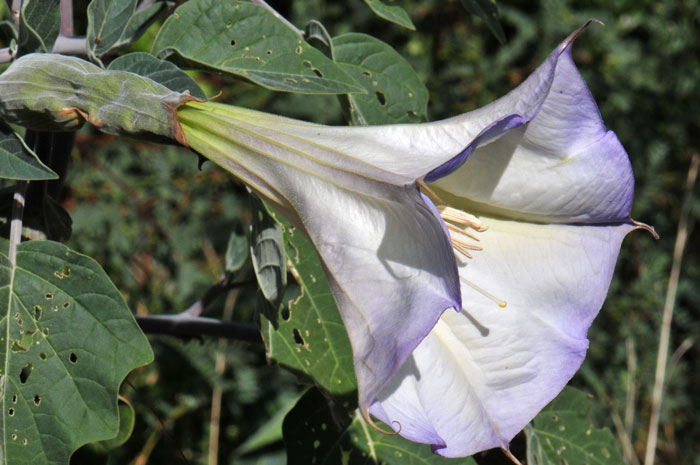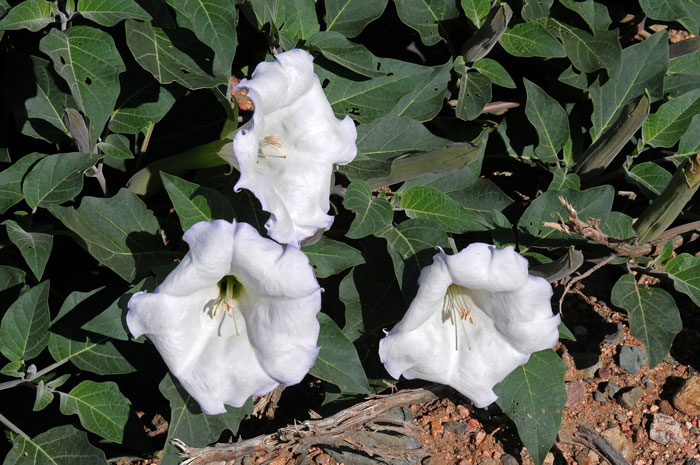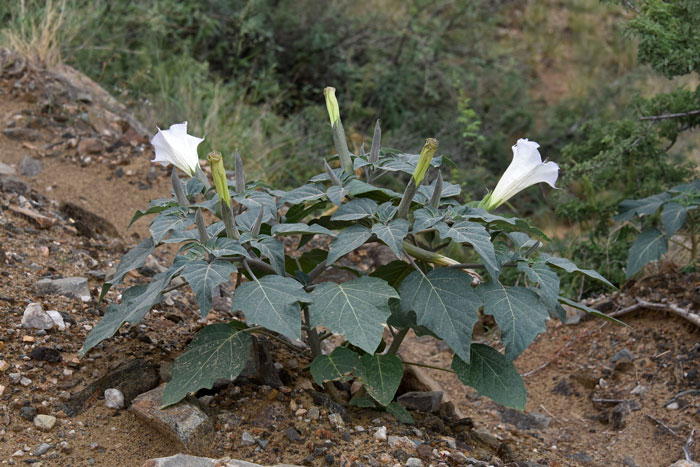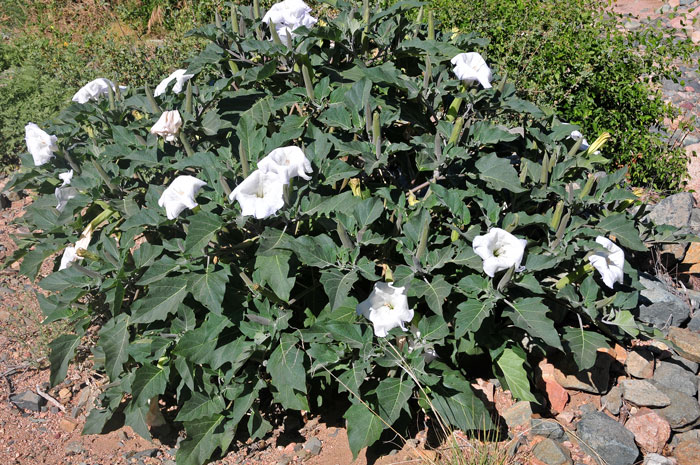Datura wrightii, Western Jimson Weed




Scientific Name: Datura wrightii
Common Name: Western Jimson Weed
Also Called: Angel's Trumpet, Devil's Weed, Indian-apple, Jimson Weed, Pricklyburr, Sacred Datura, Sacred Thorn-apple, Sacred Thornapple, Thornapple (Spanish: Toloachè, Toloachè Grande, Tecuyaui, Belladona)
Family: Solanaceae, Nightshade or Potato Family
Synonyms: (Datura inoxia subsp. quinquecuspida, Datura metel var. quinquecuspida, Datura innoxia var. quinquecuspidata, Datura meteloides)
Status: Native
Duration: Annual, perennial.
Size: Up to 4 feet more or less.
Growth Form: Forb/herb; herbage whitish or canescent-puberulent
Leaves: Green; ovate, margins entire or sinuate-dentate.
Flower Color: White, pale lavender; showy flowers protrude or extend outward from a mass of large leaves; corolla trumpet shaped or broadly funnel-shaped, 5-toothed, flower erect to nodding; closing by early morning; corolla up to 8 inches long; calyx up to 5 inches long; fruit puberulent, not viscid puberulent; nodding, bursting irregularly, globose or globular or nearly so, spines slender usually less than ⅓ inch or so; seeds light brown when ripe.
Flowering Season: May to October; April to October in California; May to November in Texas.
Elevation: 1,000 to 5,500 feet; below 7,000 feet in California.
Habitat Preferences: Roadsides, along ditches, in sandy- sandy-loam soils, or gravelly open areas.
Recorded Range: Western Jimson Weed is found throughout the majority of the United States; AL, AR, AZ, CA, CO, CT, FL, ID, IL, IN, KS, KY, MA, MD, ME, MI, MN, MO, NC, NE, NH, NJ, NM, NV, NY, OH, OK, PA, RI, SC, TX, UT, VA, WV, WY. It is also native to Baja California and Mexico.
North America & US County Distribution Map for Datura wrightii.
U.S. Weed Information: No information available.
Invasive/Noxious Weed Information: No information available.
Wetland Indicator: In North America Datura wrightii has the following wetland designations: Arid West, UPL; Atlantic and Gulf Coastal Plain, UPL; Eastern Mountains and Piedmont, FACU; Great Plains, UPL; Midwest, FACU; Northcentral & Northeast, FACU; Western Mountains, Valleys, and Coast, UPL.
UPL = Obligate Upland, almost never occur in wetlands
FACU = Facultative Upland, usually occur in non-wetlands, but may occur in wetlands.
Threatened/Endangered Information: No information available.
In the Southwestern United States, Arizona and California and New Mexico each have 5 species of Datura , Nevada and Utah each have 2 species and Texas has 4 species. All data is approximate and subject to taxonomic changes.
Comments: All parts, herbage, flowers, stems of Western Jimson Weed are highly toxic.
According to Arizona Flora, an early publication (Joseph Ewan; Rhodora 46: 317-323), questioned the legitimacy of the use of the name Datura meteloides. It was suggested, correctly so as it turned out, that this species should be named Datura wrightii because the name D. meteloides was actually a synonym of D. inoxia and as such was not available for re-application. The name was ultimately changed in 2012 to D. wrightii to honor Charles Wright (1811-1885), a renown world-wide botanical collector.
Arizona has 5 species of Datura; 3 native and 2 species from northern Mexico and South America.In Southwestern Desert Flora also see Desert Thorn-Apple, Datura discolor and Western Jimson Weed, Datura quercifolia.
Datura wrightii has been used as an analgesic, respiratory aid and as a hallucinogen by North American indigenous peoples.
Apache, White Mountain Drug, Ceremonial Medicine, Powdered roots used in the religious-medicine ceremonies.
Cahuilla Drug, Analgesic, Powdered leaves made into an ointment and applied as a pain killer in setting bones.
Cahuilla Drug, Hunting Medicine, Used by hunters on long treks to increase strength, allay hunger and gain power to capture game.
Cahuilla Drug, Respiratory Aid, Leaves steamed and vapor inhaled for severe bronchial or nasal congestion.
Cahuilla Other, Smoke Plant, Leaves used to smoke.
Chumash Drug, Unspecified, Most universally used hallucinogenic and medicinal plant known to man.
Costanoan Drug, Analgesic, Poultice of heated leaves applied for chest pains.
Diegueno Drug, Hallucinogen, Well known as a hallucinogenic plant used in rites marking boys' initiation into the toloache cult.
Havasupai Drug, Dermatological Aid, Leaf folded several times and rubbed onto red ant bite.
Havasupai Drug, Narcotic, Leaves or seeds, when eaten, made a person intoxicated for a day or more.
Hopi Drug, Hallucinogen, Root chewed to induce visions by medicine man while making a diagnosis.
See ethno-botanical uses at Native American Ethnobotany, University of Michigan, Dearborn.

